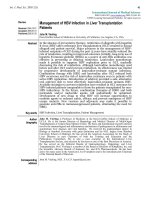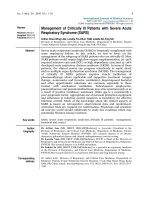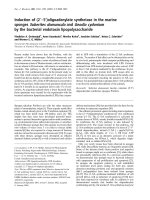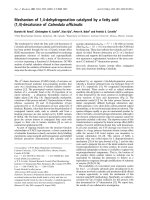Báo cáo y học: "Management of chest pain: exploring the views and experiences of chiropractors and medical practitioners in a focus group interview"
Bạn đang xem bản rút gọn của tài liệu. Xem và tải ngay bản đầy đủ của tài liệu tại đây (315.19 KB, 10 trang )
BioMed Central
Page 1 of 10
(page number not for citation purposes)
Chiropractic & Osteopathy
Open Access
Research
Management of chest pain: exploring the views and experiences of
chiropractors and medical practitioners in a focus group interview
Monica Smith, Dana J Lawrence* and Robert M Rowell
Address: Palmer Center for Chiropractic Research, Palmer College of Chiropractic, 741 Brady Street, Davenport, IA 52803, USA
Email: Monica Smith - ; Dana J Lawrence* - ; Robert M Rowell -
* Corresponding author
Chest PainChiropracticMedical EducationCoordination of Care
Abstract
Background: We report on a multidisciplinary focus group project related to the appropriate
care of chiropractic patients who present with chest pain. The prevalence and clinical management,
both diagnosis and treatment, of musculoskeletal chest pain in ambulatory medical settings, was
explored as the second dimension of the focus group project reported here.
Methods: This project collected observational data from a multidisciplinary focus group
composed of both chiropractic and medical professionals. The goals of the focus group were to
explore the attitudes and experiences of medical and chiropractic clinicians regarding their patients
with chest pain who receive care from both medical and chiropractic providers, to identify
important clinical or research questions that may inform the development of 'best practices' for
coordinating or managing care of chest pain patients between medical and chiropractic providers,
to identify important clinical or research questions regarding the diagnosis and treatment of chest
pain of musculoskeletal origin, to explore various methods that might be used to answer those
questions, and to discuss the feasibility of conducting or coordinating a multidisciplinary research
effort along this line of inquiry. The convenience-sample of five focus group participants included
two chiropractors, two medical cardiologists, and one dual-degreed chiropractor/medical
physician. The focus group was audiotaped and transcripts were prepared of the focus group
interaction. Content analysis of the focus group transcripts were performed to identify key themes
and concepts, using categories of narratives.
Results: Six key themes emerged from the analysis of the focus group interaction, including issues
surrounding (1) Diagnosis; (2) Treatment and prognosis; (3) Chest pain as a chronic, multifactorial,
or comorbid condition; (4) Inter-professional coordination of care; (5) Best practices and
standardization of care; and (6) Training and education.
Conclusion: This study carries implications for chiropractic clinical training relative to enhancing
diagnostic competencies in chest pain, as well as the need to ascertain and improve those skills,
competencies, and standards for referrals and sharing of clinical information that may improve
cross-disciplinary coordination of care for chest pain patients.
Published: 02 September 2005
Chiropractic & Osteopathy 2005, 13:18 doi:10.1186/1746-1340-13-18
Received: 29 June 2005
Accepted: 02 September 2005
This article is available from: />© 2005 Smith et al; licensee BioMed Central Ltd.
This is an Open Access article distributed under the terms of the Creative Commons Attribution License ( />),
which permits unrestricted use, distribution, and reproduction in any medium, provided the original work is properly cited.
Chiropractic & Osteopathy 2005, 13:18 />Page 2 of 10
(page number not for citation purposes)
Background
While the main focus of chiropractic care centers on treat-
ment of musculoskeletal disorders, chiropractors serve as
first point of contact with the health care system for
patients presenting with a broad range of conditions [1].
As a portal-of-entry healthcare provider in a primary
ambulatory setting, the professional responsibilities of
the practicing chiropractor include proper assessment,
documentation, and treatment of chest pain/discomfort
cases, and appropriate and timely referral of chest pain
patients as needed.
An extensive body of primary empirical literature
addresses patient management protocols (differential
diagnosis and diagnostic/treatment algorithms) for
patients presenting with chest pain, primarily focusing on
cardiopulmonary, gastroesophageal/gastrointestinal, and
psychological conditions causing chest symptoms [2-17].
These etiologic sources are ruled out as the cause for many
chest pain sufferers, and such patients essentially 'fall out
of the algorithm' with ongoing chest pain that remains
undiagnosed, untreated, and unresolved.
A small but growing body of literature estimates the pre-
sumed prevalence of musculoskeletal chest pain in medi-
cal settings at 20–50% [14-18], and reflects a growing
awareness that musculoskeletal causes remain largely
unexplored as potential sources of chest pain, particularly
for chronic or recurrent chest pain that remains undiag-
nosed and unresolved.
The Cochrane Database of Systematic Reviews (CDSR),
containing completed reviews carried out by the
Cochrane Collaboration />cochrane, contains only one citation for chest pain, not
musculoskeletal [19]. The Database of Abstracts of
Reviews of Effects (DARE), maintained by the NHS Cen-
tres for Reviews and Dissemination and linked to the
Cochrane Library />,
includes a number of reviews that focus on comparing
various clinical diagnostic test strategies for cardio-related
chest pain [20-29], as well as numerous organizational-
level studies examining the clinical safety and cost-effec-
tiveness of shifting cardio-related chest pain evaluation
units from hospital inpatient to hospital outpatient set-
tings [30-44]. Other review articles returned in the DARE
search confirms our impression that current medical
approaches to diagnosing, treating, or managing non-spe-
cific or non-cardiac chest pain focus principally on psy-
chological and gastroesophageal/gastrointestinal causes
and essentially ignore the potential for musculoskeletal
etiologies [45-51].
We report on a multidisciplinary focus group project, one
aspect of which specifically addressed issues related to the
appropriate care of chiropractic patients who present with
chest pain, whether as a main presenting complaint or as
a co-morbid condition. The prevalence and clinical man-
agement, both diagnosis and treatment, of musculoskele-
tal chest pain in ambulatory medical settings, was
explored as the second dimension of the focus group
project reported here. The objective was to gain insight
into the care and management of patients with muscu-
loskeletal chest pain as experienced by both those with
chiropractic training, medical training or combined train-
ing.
Methods
Data collection
Focus Group
This project collected observational data from a multidis-
ciplinary focus group composed of both chiropractic and
medical professionals. The goals of the focus group were
to explore the attitudes and experiences of medical and
chiropractic clinicians regarding their patients with chest
pain who receive care from both medical and chiropractic
providers, to identify important clinical or research ques-
tions that may inform the development of 'best practices'
for coordinating or managing care of chest pain patients
between medical and chiropractic providers, to identify
important clinical or research questions regarding the
diagnosis and treatment of chest pain of musculoskeletal
origin, to explore various methods that might be used to
answer those questions, and to discuss the feasibility of
conducting or coordinating a multidisciplinary research
effort along this line of inquiry.
Population, setting, timeframe
The convenience-sample of five focus group participants
included two chiropractors, two medical cardiologists,
and one dual-degreed chiropractic/medical physician. The
focus group was conducted in early 2004 at the offices of
the medical cardiologists.
Support documents/instruments
The questions posed to focus group participants are pro-
vided in Additional file 1. Aside from presenting the semi-
structured questions, running the audio recorders, and
ensuring that all questions were addressed within the time
allotted for the focus group meeting, the facilitator's role
during the focus groups session was intentionally mini-
malized in order to enhance the authenticity of the obser-
vations offered by focus group participants.
Human subjects
The Institutional Review Board of Palmer College
approved this study of human subjects, including the
Informed Consent document signed by all Focus Group
participants. To protect subject confidentiality, subject
records (i.e., signed Informed Consents and verbatim
Chiropractic & Osteopathy 2005, 13:18 />Page 3 of 10
(page number not for citation purposes)
unblinded master transcript) were maintained in a locked
file cabinet. The final 'blinded' transcript (all subject iden-
tifiers removed) was used during the content analysis,
which was performed by all three investigators, although
two of the study investigators were also present during the
focus group.
Data management and analysis
Focus Group Qualitative Analyses
The focus group was audiotaped and transcripts were pre-
pared of the focus group interaction. Content analysis of
the focus group transcripts were performed to identify key
themes and concepts, using categories of narratives. All
three authors analyzed complete transcripts and devel-
oped independent lists of overall themes and concepts
subsumed within the general themes. Once completed,
the investigators came together to collapse their lists of
themes into one set of themes as reached via consensus.
This process involved examining themes for commonal-
ity, classifying them for uniformity, and then reaching
agreement on the final list of six key themes. Once the
themes were set and subordinate concepts identified, each
investigator looked for quotes and comments which
exemplified those themes and concepts (which are pre-
sented in the Results, below)
As a methodological 'cross-check', the investigative
group's consensus process confirmed observations drawn
from each investigator's independent analysis of the tran-
scripts, which strengthened the validity and reliability of
the study findings reported from this qualitative research
[52,53]. It is important to note that this research is an
exploration into the specifics of the convenience sample
drawn for the project; therefore, generalizability is not a
significant consideration in this study.
Results
Six key themes emerged from the analysis of the focus
group interaction, including issues surrounding (1) Diag-
nosis; (2) Treatment and prognosis; (3) Chest pain as a
chronic, multifactorial, or comorbid condition; (4) Inter-
professional coordination of care; (5) Best practices and
standardization of care; and (6) Training and education.
These thematic issues are summarized below, and key
excerpts from the focus group transcript exemplifying
these thematic issues are included in Additional file 2.
(1) Diagnosis
Participants reported that a good history and physical
exam are essential and important to good diagnosis, that
a history should include all prior care received for that
condition, that records of prior care should be obtained
directly from the source provider, and that history, exam,
and differential diagnosis are central to the provision of
portal-of-entry primary care as well as secondary specialty
care. They noted that diagnostic uncertainty, complexity,
and discriminant variability are characteristic of chest
pain assessment and diagnostic tests, that the inherently
high risk of chest pain determines the order of differential
workup and the path of diagnostic referral care (e.g., rule
out cardiac and other major medical conditions first), and
that musculoskeletal chest pain is principally a diagnosis
by exclusion. Anecdotal experience of both chiropractic
and medical cardiology focus group participants confirms
reports in the literature of a high prevalence of suspected
musculoskeletal chest pain in ambulatory practice set-
tings.
(2) Treatment and prognosis
Chiropractic participants reported anecdotal evidence
(their personal practice experience) of the effectiveness of
manual/manipulative approaches to resolve chest pain of
suspected musculoskeletal origin. Chiropractic and medi-
cal participants both noted lack of formal clinical studies
examining effectiveness of manual/manipulative
approaches to manage (diagnose and treat) musculoskel-
etal chest pain, and lack of evidence supporting effective-
ness for medical drug interventions for musculoskeletal
chest pain (e.g., oral nonsteroidal anti-inflammatory
drugs or steroid injections into chest wall), and that it is
unknown to what extent drug interventions are prescribed
for such conditions in actual current medical practice
(generalist or specialist). The agreed that both effective-
ness and safety concerns should direct the appropriate-
ness and order of trying various clinical approaches to
resolve musculoskeletal chest pain in a given patient, and
that a better understanding of the etiology of muscu-
loskeletal chest pain condition(s) would also help dis-
criminate between different conditions and guide the
search for identifying effective interventions for a given
condition. Natural history or prognosis of treated versus
untreated acute or chronic musculoskeletal chest pain is
also unknown.
(3) Chest pain as a chronic, multifactorial, or comorbid
condition
It is unknown to what extent chronic, unresolved chest
pain may represent undiagnosed musculoskeletal chest
pain, or to what extent patients with undiagnosed and
unresolved musculoskeletal chest pain are perhaps being
misclassified as psychological or psychiatric cases. The
participants commented that chronic recalcitrant chest
pain is associated with high resource use and unsatisfied,
distressed patients, that it is unknown to what extent early
manual/manipulative intervention in acute musculoskel-
etal chest pain may prevent development of chronic mus-
culoskeletal chest pain, that chronic musculoskeletal chest
pain may raise patient care issues similar to other chronic
conditions (i.e., providers and patients may manage some
chronic conditions, rather than resolve them), and that
Chiropractic & Osteopathy 2005, 13:18 />Page 4 of 10
(page number not for citation purposes)
the diagnostic and treatment considerations are further
complicated when musculoskeletal chest pain and non-
musculoskeletal chest pain may exist together as related or
unrelated comorbidities. Finally, they noted that with a
higher likelihood of degenerative musculoskeletal disor-
ders in older patients and also higher likelihood of vis-
ceral (cardiopulmonary or gastrointestinal) disorders in
older patients, chest pain in older patients therefore may
be more likely of multi-factorial etiology and more likely
associated with comorbidities.
(4) Inter-professional coordination of care
Participants reported that referrals should be based on evi-
dence of efficacy/effectiveness for a given condition such
as musculoskeletal chest pain, that the path of referral for
chest pain will depend on the nature of the condition and
the urgency of the situation, that the point of referral may
depend on the familiarity or relationship between the
providers, and that the nature of the referral (e.g., amount
and type of information accompanying the referral) may
depend on the nature of the condition, whether the refer-
ral is for reasons of diagnosis and/or treatment, the pref-
erence of the provider, and the relationship between the
providers. Medical specialists (e.g., cardiology) who
receive referrals from primary medical practitioners will
most typically return the patient to the primary medical
practitioner rather than referring them elsewhere,
although this also may depend on the nature of the con-
dition and the relationship between the specialty and pri-
mary medical practitioner.
Participants felt that patients with co-morbidities (e.g.,
having both musculoskeletal and non-musculoskeletal
chest pain) may be more likely to receive concurrent care
from more than one provider, that providers can pro-
actively improve interprofessional relationships by being
diligent about sharing pertinent information and reports
during referrals. Participants felt that educating other pro-
viders about available evidence, recognizing and address-
ing issues of professional boundary protection (often
referred to as 'turf'), and that patients' direct experience
(with successful or unsuccessful treatment outcome) and
their preferences will also impact provider perceptions
and interprofessional relationships.
(5) Best practices and standardization of care
Participants reported that standardizing care within pro-
fessions may facilitate opportunities for interprofessional
referrals, that guidelines and care standards are an issue
for all professions, that interactions between providers
and professions (e.g. referrals) may also be standardized,
and that 'best practices' for coordinating musculoskeletal
chest pain care would center on the role of primary medi-
cal practitioners rather than specialist medical practition-
ers.
(6) Training/Education
Competencies in exam, diagnostic, and clinical decision-
making skills for chest pain were raised as issues for, and
by, both chiropractors and medical practitioners. Medical
practitioners' perception, familiarity and comfort with
chiropractors' diagnostic skills largely comes via direct
exposure in postgraduate practice (exchanging clinical
reports, etc.) rather than during their medical training.
Participants commented that there is a perception that
medical education/training is more standardized than
chiropractic, and a perception that medical practice is
more consistent with medical training (i.e., chiropractors'
clinical practice may be more likely to deviate from what
they were taught). A comment was made that medical
training includes developing skills/competencies in refer-
ral practices (e.g., standardized referral forms are used in
medical academic practice and teaching clinics).
Discussion
The focus group dialogue suggested several implications
for current and future chiropractic practice, undergraduate
and post-professional chiropractic education and clinical
training, research, and professional organization or pol-
icy. These implications for practice, education, research,
and policy are summarized below along with our recom-
mendations.
Clinical practice
With all portal-of-entry providers such as chiropractors,
the responsibility to diagnose chest pain is vital. The focus
group touched on this point several times. In order to
arrive at a diagnosis for chest pain, or any other condition,
they stressed the importance of first taking a good history
and then performing a thorough examination. The diag-
nosis of chest pain, however, is complicated and requires
excellent diagnostic skills. The focus group (both the chi-
ropractors and the medical practitioners) expressed a con-
cern over the ability of chiropractors to accurately
diagnose chest pain. In order for chiropractors to have a
role in managing chest pain from the point of entry, they
must acquire and demonstrate competence in diagnosing
the complaint.
Chest pain can have a multitude of etiologies, involves an
inherently high level of diagnostic uncertainty, and diag-
nostic algorithms are complex. The clinician's most
immediate concern is ruling out emergent versus non-
emergent conditions [54-58]. The focus group partici-
pants were unified in voicing the need for rapid diagnosis
and management for cardiopulmonary conditions such as
myocardial infarction and pulmonary embolism, among
others. They also pointed out that the clinical picture of
chest pain can be complicated by simultaneous etiologies.
For example, one of the medical doctors noted that in his
own practice he saw patients with cardiac disease and
Chiropractic & Osteopathy 2005, 13:18 />Page 5 of 10
(page number not for citation purposes)
chest wall tenderness. This sentiment was echoed by one
of the chiropractors who noted that simply palpating a
patient's chest wall and finding tenderness does not rule
out cardiac or other life threatening causes of chest pain.
Therefore, a full chest pain work up must include evalua-
tions for cardiac, pulmonary, gastrointestinal, muscu-
loskeletal and psychological causes of chest pain.
Once life threatening causes of chest pain have either been
ruled out or managed, other possible etiologies may be
investigated. The focus group expressed concern that mus-
culoskeletal chest pain may be either missed or misdiag-
nosed as psychological in nature. The misdiagnosis of
musculoskeletal chest pain as psychological could cause
much distress, cost, and unnecessary suffering for
patients. It is important, therefore, to investigate efficient
and accurate diagnostic strategies for this complaint.
Participants in the focus group commented that muscu-
loskeletal chest pain is common in their practices, both
chiropractic and medical. This is consistent with reports in
the literature that 20%–50% of chest pain presentations
in ambulatory settings may be musculoskeletal [14-18].
Management of chest pain of cardiac or gastrointestinal
origin is much more standardized than musculoskeletal
chest pain. Appropriate protocols and treatment algo-
rithms do not exist for musculoskeletal chest pain. Manip-
ulation, physiological therapeutics, injections, analgesics,
and other treatments may be employed, but none have
been extensively investigated.
The opportunity for cross-disciplinary coordination of
care for chest pain certainly exists. Unfortunately, effective
referral pathways do not exist. Chest pain in medical prac-
tice is often diagnosed by cardiologists who then send
patients back to their referring clinicians, most likely a pri-
mary care medical physician. Therefore, it is important to
ascertain and possibly improve those skills, competencies,
and standards for referrals and sharing of clinical informa-
tion that may improve current and future cross-discipli-
nary coordination of care for chest pain patients.
Clinical and health services research
It is apparent that there is insufficient scientific evidence
to guide clinical practice and decision making for muscu-
loskeletal chest pain. The focus group chiropractic partici-
pants largely reported only personal anecdotal evidence
for the effectiveness of manipulative interventions for
chest pain of suspected musculoskeletal origin, and both
the chiropractors and medical practitioners commented
upon this lack of evidence, both in terms of therapy as
well as for diagnosis. Similarly, there is a concomitant lack
of evidence supporting the chemotherapeutic interven-
tions used by medical doctors for suspected musculoskel-
etal chest pain.
Thus, there is much that is not known. Research questions
worth investigating include:
• What is the incidence and prevalence of musculoskeletal
chest pain in chiropractic clinical practice?
• What is the incidence and prevalence of musculoskeletal
chest pain in specialist cardiologist practice? In general
medical practice?
• What percentage of chiropractors treat musculoskeletal
chest pain compared to those who refer out for care?
• How effective is manipulation for treating musculoskel-
etal chest pain?
• What other modalities do chiropractors use during such
treatments?
• What diagnostic methods are used for determining the
presence of musculoskeletal chest pain? What is the relia-
bility, validity, sensitivity and specificity of each test?
• What are the costs involved in treating such cases?
• What interdisciplinary models exist with regard to devel-
oping coordinated-care protocols for diagnosis and treat-
ment of acute musculoskeletal chest pain? For long-term
management of chronic or recurrent musculoskeletal
chest pain?
• Do incidence and prevalence rates vary geographically
or by setting?
One challenge relative to chiropractic research is that
funding sources are limited and few opportunities exist.
So, this presents a conundrum, in that more research is
needed but the greatest amount of resources (both fund-
ing, and limited research workforce) are directed toward
conditions which are already well established with regard
to chiropractic research: low back pain, neck pain, and
headache.
A Search using the key terms "Chiropractic" and "Muscu-
loskeletal Chest Pain" on PubMed yielded only three
papers, two of which had no real pertinence to the issue at
hand. The third paper was a case report that looked at
using a specific chiropractic adjusting procedure for man-
aging chronic chest pain [59]. There were no randomized
trials found in the literature. Shifting the search to the
terms "Medicine" and "Musculoskeletal Chest Pain"
improved the yield to just nine papers, one of which was
a repeat from the chiropractic search, and several of which
were tangential to this issue. Obviously, this is an area
needing far more research.









